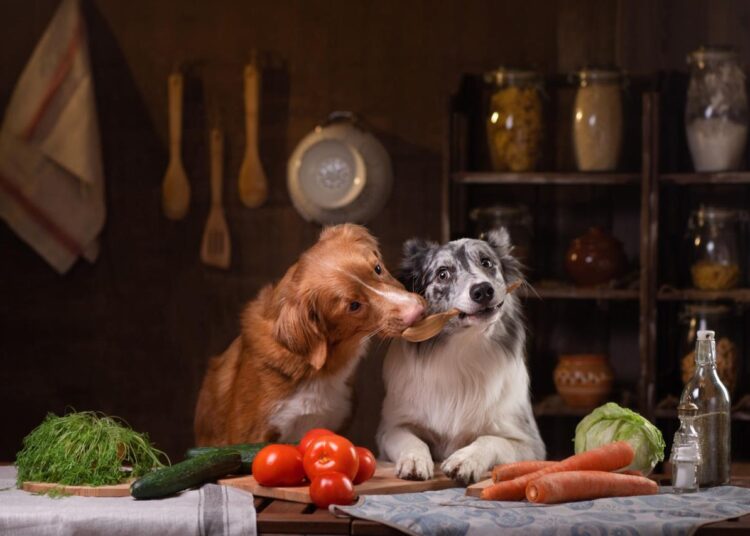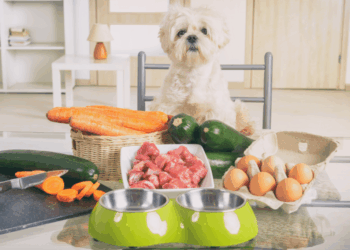The way we feed our beloved animal companions is undergoing a profound transformation. Beyond simply providing nutrition, there’s a growing global awareness about the environmental footprint of pet food production. As pet ownership continues to rise, so does the demand for more sustainable pet food options that prioritize the planet’s health alongside our pets’ well-being. This shift isn’t just a fleeting fad; it’s a critical movement driven by consumer demand, scientific innovation, and a collective commitment to a greener future.From ethically sourced ingredients to eco-friendly packaging and reduced waste, the concept of sustainable pet food encompasses a broad spectrum of practices. This article delves into the emerging trends, the pressing reasons behind this movement, and what pet owners can do to make more environmentally conscious choices for their furry, feathered, or scaled family members.
The Environmental Paw Print

Understanding the environmental impact of conventional pet food is the first step toward appreciating the need for change. The global pet food industry is a massive enterprise, consuming significant resources and contributing to various environmental challenges.
A. Resource Consumption
Traditional pet food often relies heavily on animal proteins, particularly from livestock, which require substantial resources:
- Land Use: Vast tracts of land are needed for grazing animals and cultivating crops for animal feed. Deforestation for agricultural expansion contributes to habitat loss and biodiversity decline.
- Water Footprint: Livestock farming is incredibly water-intensive, from irrigating crops to providing drinking water for animals and processing facilities.
- Energy Use: Energy is consumed at every stage, from farming and harvesting to processing, packaging, and transportation of ingredients and finished products.
B. Greenhouse Gas Emissions
The livestock sector is a major contributor to greenhouse gas (GHG) emissions, particularly methane (from enteric fermentation in ruminants) and nitrous oxide (from manure management and synthetic fertilizers). These gases are far more potent than carbon dioxide in their short-term warming potential. The transportation of ingredients and finished products further adds to the carbon footprint.
C. Waste Generation
The pet food industry generates significant waste:
- Food Waste: While pet food often utilizes by-products from human food production, some argue that the sheer volume of pet food produced still contributes to overall food system waste if not managed efficiently.
- Packaging Waste: A vast amount of pet food packaging ends up in landfills, contributing to plastic pollution and microplastic contamination. Many conventional packaging materials are difficult or impossible to recycle.
D. Biodiversity Loss
Intensive agricultural practices and overfishing, driven in part by demand for pet food ingredients, can negatively impact biodiversity, depleting natural fish stocks and encroaching on wild habitats.
Recognizing these impacts has propelled consumers and manufacturers alike to seek more responsible and eco-conscious alternatives.
Pillars of Sustainable Pet Food
The concept of sustainable pet food isn’t monolithic; it’s built upon several interconnected pillars aimed at minimizing environmental harm and promoting ethical practices.
A. Novel and Alternative Protein Sources
Perhaps the most significant innovation in sustainable pet food is the exploration of protein sources beyond conventional livestock.
- Insect-Based Proteins: Insects like black soldier fly larvae are highly nutritious, require significantly less land, water, and feed than traditional livestock, and emit far fewer greenhouse gases. They are also highly digestible for many pets and can be a good option for pets with allergies to common proteins.
- Lab-Grown (Cultivated) Meat: While still in early development for pet food, cultivated meat offers the promise of real animal protein without the need for raising and slaughtering animals, drastically reducing environmental impact.
- Plant-Based and Vegan Diets: Formulated with proteins from legumes, grains, and vegetables, these diets are gaining traction, especially among owners who follow vegetarian or vegan lifestyles themselves. Careful formulation is crucial to ensure complete and balanced nutrition for pets, particularly for cats who have specific dietary needs (e.g., taurine).
- Algae and Fungi-Based Proteins: Microalgae and certain fungi can be cultivated sustainably to produce protein-rich ingredients with minimal resource use.
- Upcycled Ingredients: Utilizing by-products from the human food industry that would otherwise go to waste (e.g., spent brewer’s grains, fruit and vegetable pulps) reduces food waste and creates a circular economy.
B. Ethical Sourcing and Traceability
Sustainable pet food emphasizes transparency and responsibility in its supply chain.
- Humanely Raised Animals: For pet foods that still use traditional meat, there’s a growing demand for certifications that guarantee animals were raised without antibiotics, growth hormones, and with respect for their welfare.
- Sustainable Fishing Practices: Ingredients like fish meal should come from fisheries that adhere to sustainable practices, preventing overfishing and protecting marine ecosystems. Certifications like the Marine Stewardship Council (MSC) are important indicators.
- Local Sourcing: Prioritizing ingredients sourced from nearby farms and producers reduces transportation emissions and supports local economies.
- Fair Trade Practices: Ensuring that farmers and workers involved in the supply chain receive fair wages and work in ethical conditions.
C. Eco-Friendly Packaging Solutions
Reducing the environmental impact of packaging is a critical component of sustainability.
- Recyclable Materials: Shifting from multi-laminate plastic bags (which are difficult to recycle) to single-material plastics (like polyethylene), paper, or cardboard that are widely recyclable.
- Compostable or Biodegradable Packaging: Packaging made from plant-based materials that can break down naturally in industrial composting facilities or home compost bins.
- Post-Consumer Recycled (PCR) Content: Using materials that have already been recycled, reducing the demand for virgin plastics.
- Reduced Packaging: Optimizing packaging design to minimize material use without compromising product integrity.
- Refill Programs and Bulk Options: Some brands are exploring refillable containers or bulk purchasing options to reduce single-use packaging.
D. Reduced Carbon Footprint in Production
Manufacturers are adopting more energy-efficient practices in their facilities.
- Renewable Energy Sources: Powering production facilities with solar, wind, or other renewable energy.
- Water Conservation: Implementing water-saving technologies and recycling water within the production process.
- Waste Reduction in Manufacturing: Minimizing waste during formulation, cooking, and packaging.
E. Transparency and Certifications
Consumers are increasingly looking for clear information and third-party verification of sustainability claims.
- Clear Labeling: Brands are providing more detailed information about ingredient origins, processing methods, and environmental certifications.
- Third-Party Certifications: Certifications from reputable organizations (e.g., B Corp, USDA Organic, MSC, various humane certifications) provide independent verification of sustainable practices.
Emerging Trends in Sustainable Pet Food

The landscape of sustainable pet food is dynamic, with exciting innovations continually emerging.
A. Hyper-Local and Farm-to-Bowl Concepts
Moving beyond just “local,” some brands are emphasizing direct sourcing from specific farms, offering unparalleled traceability and supporting smaller, ethical producers. This model often involves minimal processing, preserving nutritional integrity.
B. Customized and Precision Nutrition with a Sustainable Lens
As pet health monitoring becomes more sophisticated, the ability to create highly personalized diets based on an individual pet’s needs (age, breed, activity level, health conditions) is growing. This can reduce food waste by ensuring pets get exactly what they need, potentially with sustainably sourced ingredients.
C. “Ugly” Produce and Upcycled Ingredients as a Mainstay
The concept of using fruits, vegetables, or even animal parts deemed “unfit” for human consumption (due to aesthetic imperfections or being by-products) is gaining traction. This significantly reduces food waste within the broader food system.
D. Investment in Sustainable Agriculture Practices
Pet food companies are not just buying sustainable ingredients; some are investing directly in developing more sustainable farming methods, supporting regenerative agriculture that improves soil health and sequesters carbon.
E. Waterless or Low-Water Formulations
Developing pet food formulas that require less water during production, or even “waterless” options like freeze-dried or air-dried foods, contributes to water conservation.
F. Returnable and Reusable Packaging Models
Following the human consumer trend, some brands are experimenting with returnable containers or subscription models where pet food is delivered in reusable bins, significantly cutting down on single-use waste.
How Pet Owners Can Contribute to Sustainable Pet Food Practices
Making sustainable choices doesn’t require a complete overhaul; even small steps can make a big difference.
A. Research Brands and Their Practices
Don’t just look at the front of the bag. Dig deeper into a brand’s website to understand their sourcing, manufacturing processes, and commitment to sustainability. Look for clear statements and certifications.
B. Consider Alternative Protein Diets
Explore insect-based pet foods or well-formulated plant-based options. Many pets thrive on these diets, and they offer a significantly reduced environmental footprint. Consult your veterinarian before making significant dietary changes, especially for cats.
C. Prioritize Sustainable Packaging
When shopping, consciously choose products with recyclable, compostable, or reduced packaging. Look for options with PCR content. If available, explore bulk buying or local refill stations.
D. Reduce Food Waste at Home
- Portion Control: Feed your pet appropriate amounts to prevent overeating and wasted food.
- Proper Storage: Store pet food correctly to maintain freshness and prevent spoilage.
- Repurpose Leftovers: If safe and appropriate, a small amount of human-grade food scraps can be incorporated into a pet’s diet, provided it’s balanced and approved by a vet.
E. Support Local and Ethical Producers
Seek out small, local pet food producers who emphasize local sourcing and ethical practices. This not only reduces the carbon footprint of transportation but also supports responsible businesses.
F. Advocate for Change
Engage with pet food brands on social media, send emails, or participate in surveys to voice your demand for more sustainable options. Consumer pressure is a powerful catalyst for industry change.
G. Compost or Recycle Appropriately
Ensure you’re properly recycling any recyclable pet food packaging and composting any compostable materials according to local guidelines.
Addressing Common Concerns and Misconceptions
As with any shift, there are often questions and misconceptions surrounding sustainable pet food.
A. Nutritional Adequacy
A common concern is whether alternative protein or plant-based diets are nutritionally complete for pets.
- Fact: Many reputable brands employ veterinary nutritionists to formulate diets that meet or exceed the nutritional requirements set by organizations like the Association of American Feed Control Officials (AAFCO) in the US or FEDIAF in Europe. It’s crucial to choose products from well-established companies with transparent nutritional information.
- Action: Always look for an AAFCO or FEDIAF statement of nutritional adequacy on the label.
B. Palatability
Will pets actually eat insect-based or plant-based foods?
- Fact: Many pets readily accept novel proteins. Manufacturers often use palatants to ensure taste appeal. Insect proteins, in particular, often have a mild, nutty flavor that pets enjoy.
- Action: If transitioning, do so gradually over 7-10 days, mixing increasing amounts of the new food with the old.
C. Cost
Sustainable options can sometimes be more expensive.
- Fact: Innovative ingredients and ethical sourcing can initially lead to higher production costs. However, as demand grows and production scales, prices are likely to become more competitive.
- Action: Consider the long-term benefits for the environment and your pet’s health. Some sustainable options might offer better overall value despite a higher upfront cost.
D. Availability
Are sustainable pet food options widely available?
- Fact: While still a niche compared to conventional brands, the availability is rapidly increasing in pet stores, online retailers, and even some supermarkets.
- Action: Use online search engines, check specialty pet stores, and ask your local pet retailer about their sustainable options.
The Role of Innovation and Collaboration
The future of sustainable pet food will depend heavily on continued innovation and collaboration across various sectors.
A. Scientific Research and Development
Ongoing research is vital to identify new sustainable ingredients, optimize their nutritional profiles, and improve processing methods to reduce environmental impact. This includes studies on digestibility, allergenicity, and long-term health outcomes of novel diets.
B. Industry Partnerships
Collaboration between ingredient suppliers, pet food manufacturers, packaging companies, and even waste management services is essential to create a truly circular and sustainable supply chain. Sharing best practices and developing industry-wide standards can accelerate progress.
C. Regulatory Support and Consumer Education
Government bodies can play a role by supporting sustainable agricultural practices, setting clearer guidelines for labeling, and promoting environmentally friendly production. Simultaneously, ongoing consumer education is crucial to inform pet owners about their choices and demystify sustainable pet food options.
D. Technological Advancements
New technologies in precision fermentation, cellular agriculture, and advanced recycling will continue to unlock new possibilities for sustainable ingredient production and waste reduction. Data analytics can also help optimize supply chains and reduce waste.
Conclusion
The journey towards sustainable pet food is not just an industry trend; it’s a reflection of a deeper commitment to the health of our planet and the well-being of our animal companions. By embracing innovative protein sources, demanding ethical sourcing, prioritizing eco-friendly packaging, and reducing waste, we can collectively steer the pet food industry toward a greener, more responsible future.
Every decision we make as pet owners, from the type of food we choose to how we dispose of its packaging, contributes to a larger impact. By becoming informed consumers and actively seeking out sustainable options, we can ensure that our furry, scaled, or feathered friends not only receive optimal nutrition but also leave a lighter, greener paw print on the Earth. The revolution is underway, one bowl at a time, for a healthier planet and happier pets.









